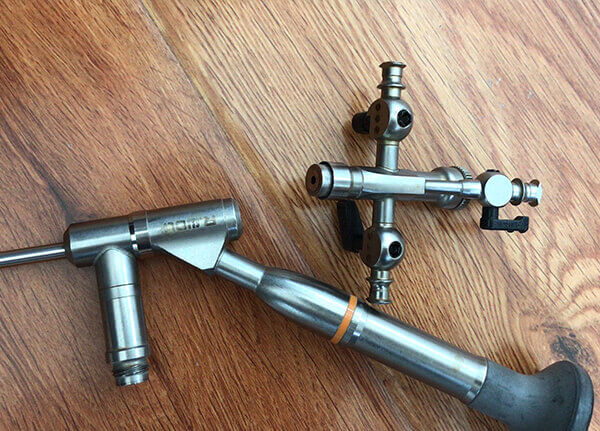欢迎来到匠仁医疗设备有限公司网站!

在医疗诊断、工业检测等领域,内窥镜凭借其能够深入人体或设备内部进行观察的特性,成为不可或缺的工具。然而,长期使用过程中,内窥镜难免出现故障,需要专业维修。在众多维修技术中,冷冻修复技术因其独特的处理方式引发关注,那么内窥镜维修是否涉及冷冻修复?这需要从内窥镜的故障类型、冷冻修复的原理与特点等方面进行深入探究。
In fields such as medical diagnosis and industrial testing, endoscopes have become an indispensable tool due to their ability to observe deeply inside the human body or equipment. However, during long-term use, endoscopes are inevitably prone to malfunctions and require professional maintenance. Among various repair techniques, cryogenic repair technology has attracted attention due to its unique processing method. Does endoscopic repair involve cryogenic repair? This requires in-depth exploration from the types of malfunctions of endoscopes, the principles and characteristics of cryogenic repair, and other aspects.
冷冻修复技术原理与特点
Principles and characteristics of cryogenic repair technology
1.技术原理
1. Technical principles
冷冻修复技术主要是利用低温环境,使材料发生物理或化学变化,从而实现修复目的。在低温条件下,材料的分子运动减缓,一些因热胀冷缩产生的微小裂缝、变形等问题,可能因材料收缩而重新贴合。对于某些复合材料,低温还能促进材料内部的应力释放,改善其物理性能。此外,冷冻环境可以使一些附着在部件表面的杂质、污垢因热胀冷缩差异而松动,便于清理。
Cryoremediation technology mainly utilizes low-temperature environments to cause physical or chemical changes in materials, thereby achieving the purpose of remediation. Under low temperature conditions, the molecular motion of materials slows down, and some small cracks, deformations, and other issues caused by thermal expansion and contraction may reattach due to material shrinkage. For some composite materials, low temperature can also promote stress release inside the material and improve its physical properties. In addition, a frozen environment can loosen impurities and dirt attached to the surface of components due to differences in thermal expansion and contraction, making it easier to clean.
2.技术特点
2. Technical features
冷冻修复技术具有非接触性、对材料损伤小的特点。与传统的焊接、粘接等修复方式相比,它不会引入额外的材料或改变部件的原始结构,能最大程度保持部件的原有性能。而且,冷冻修复过程相对快速,可在较短时间内完成对部件的处理,提高维修效率。不过,该技术对操作环境和设备要求较高,需要专业的低温设备来实现精确的温度控制,同时,并非所有材料都适用于冷冻修复,需要根据材料特性谨慎选择。
Cryoremediation technology has the characteristics of non-contact and minimal damage to materials. Compared with traditional repair methods such as welding and bonding, it does not introduce additional materials or change the original structure of the component, and can maintain the original performance of the component to the greatest extent possible. Moreover, the freezing repair process is relatively fast and can complete the processing of components in a short period of time, improving maintenance efficiency. However, this technology has high requirements for the operating environment and equipment, requiring professional low-temperature equipment to achieve precise temperature control. At the same time, not all materials are suitable for cryogenic repair, and careful selection is needed based on material characteristics.

冷冻修复在内窥镜维修中的适用性分析
Applicability analysis of cryogenic repair in endoscopic maintenance
1.光学系统方面
1. In terms of optical system
对于光学系统中镜头表面的微小划痕,冷冻修复技术有一定的应用潜力。在低温环境下,镜头材料收缩,部分微小划痕可能因表面材料的轻微位移而变得不那么明显,从而在一定程度上改善成像质量。但对于较深的划痕,冷冻修复无法从根本上解决问题,仍需采用研磨、抛光等传统修复方法。对于导光束,冷冻修复难以解决其内部光纤断裂或老化问题,因为光纤的修复需要专业的熔接技术,与冷冻修复的作用原理不同。
Freeze repair technology has certain potential applications for small scratches on the surface of lenses in optical systems. In low-temperature environments, the lens material shrinks, and some small scratches may become less noticeable due to slight displacement of the surface material, thereby improving imaging quality to a certain extent. However, for deeper scratches, frozen repair cannot fundamentally solve the problem and traditional repair methods such as grinding and polishing still need to be used. For light guide beams, cryogenic repair is difficult to solve the problem of internal fiber breakage or aging, because fiber repair requires professional fusion splicing technology, which is different from the principle of cryogenic repair.
2.机械结构方面
2. In terms of mechanical structure
在机械结构故障修复中,冷冻修复技术可用于处理弯曲部橡胶外皮的轻微变形。低温使橡胶收缩,有可能使变形部位恢复一定的形状,但对于钢丝断裂、严重磨损等问题,冷冻修复无能为力,需要更换相应的零部件。而控制手柄的机械故障,如内部弹簧、齿轮的损坏,冷冻修复也无法起到修复作用,通常需要拆解手柄进行零件更换或维修。
In the repair of mechanical structural faults, cryogenic repair technology can be used to deal with slight deformation of the rubber outer skin in curved parts. Low temperature causes rubber to shrink, which may restore a certain shape to the deformed area. However, for problems such as wire breakage and severe wear, cryogenic repair is powerless and requires replacement of corresponding components. However, mechanical failures of the control handle, such as damage to internal springs and gears, cannot be repaired by freezing, and usually require disassembling the handle for parts replacement or repair.
3.电气系统方面
3. In terms of electrical system
电气系统故障多涉及电子元件的损坏、线路的断裂等问题,冷冻修复技术基本无法应用。电子元件的故障通常需要通过更换损坏元件、焊接修复线路等方式解决,低温环境不仅不能修复这些问题,还可能对部分敏感电子元件造成损害,影响设备性能。
Electrical system failures often involve damage to electronic components, breakage of circuits, and other issues, and cryogenic repair technology is basically not applicable. The malfunction of electronic components usually needs to be solved by replacing damaged components, welding and repairing circuits, etc. Low temperature environments not only cannot repair these problems, but may also cause damage to some sensitive electronic components, affecting equipment performance.
本文由内窥镜设备维修友情奉献.更多有关的知识请点击:http://www.jiangrenyiliao.cn我们将会对您提出的疑问进行详细的解答,欢迎您登录网站留言.
This article is a friendly contribution from the maintenance of endoscopic equipment For more information, please click: http://www.jiangrenyiliao.cn We will provide detailed answers to your questions. You are welcome to log in to our website and leave a message
 公司:匠仁医疗设备有限公司
公司:匠仁医疗设备有限公司 樊经理:13153199508 李经理:13873135765
公司地址:山东省济南市槐荫区美里东路3000号德迈国际信息产业园6号楼101-2室 湖南省长沙市雨花区劳动东路820号恒大绿洲14栋2409室
备案号:鲁ICP备2023027194号-1 鲁公网安备 37010402441281号